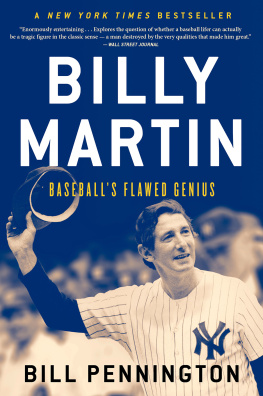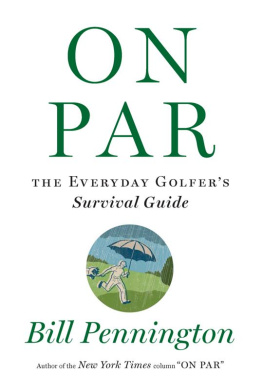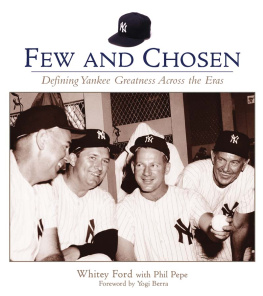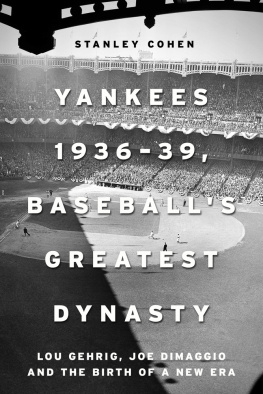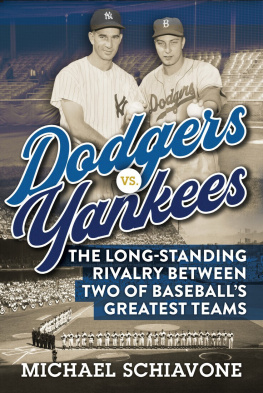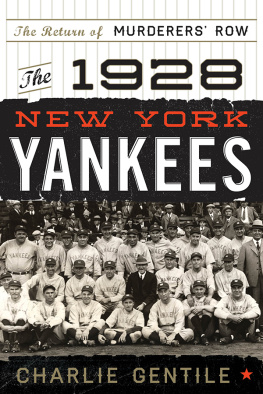Copyright 2019 by Bill Pennington
All rights reserved
For information about permission to reproduce selections from this book, write to or to Permissions, Houghton Mifflin Harcourt Publishing Company, 3 Park Avenue, 19th Floor, New York, New York 10016.
hmhbooks.com
Library of Congress Cataloging-in-Publication Data
Names: Pennington, Bill, 1956 author.
Title: Chumps to champs : how the worst teams in Yankees history led to the 90s dynasty / Bill Pennington.
Description: Boston : Houghton Mifflin Harcourt, [2019] | Includes bibliographical references and index.
Identifiers: LCCN 2018046434 (print) | LCCN 2018051095 (ebook) | ISBN 9781328849878 (ebook) | ISBN 9781328849854 (hardback)
Subjects: LCSH: New York Yankees (Baseball team)History20th century. | Baseball playersNew York (State)New YorkBiography. | Baseball managersNew York (State)New YorkBiography. | BISAC: SPORTS & RECREATION / Baseball / History. | HISTORY / United States / State & Local / Middle Atlantic (DC, DE, MD, NJ, NY, PA).
Classification: LCC GV875.N4 (ebook) | LCC GV875.N4 P45 2019 (print) | DDC 796.357/64097471dc23
LC record available at https://lccn.loc.gov/2018046434
Cover design by Mark R. Robinson
Cover photograph (top) Douglas C. Pizac / Associated Press
Cover photograph (bottom) Linda Cataffo / New York Daily News archive
Author photograph Nina Subin
v1.0419
To Joyce, Anne D., Elise and Jack,
the ultimate home team advantage
Introduction
IT WAS A sunny Sunday in Chicago, and Andy Hawkins, a journeyman pitcher with a career losing record, was only four outs from baseball immortality. Working briskly through the Chicago White Sox lineup that day, July 1, 1990, Hawkins had retired 23 batters without yielding a hit. There were two outs in the bottom of the eighth inning.
For Hawkins, in his second year with the New York Yankees, it was and would be the game of his life. And it had come out of nowhere. Just a few weeks earlier, he trudged off the mound after getting only one out in a starting assignment, trailing 50 in the first inning. In another game that month, he faced only 12 batters, with half of them getting hits and a third smacking triples or doubles. At that point, the Yankees planned to either cut Hawkins or demote him to the minor leagues. Only an injury to a teammate had kept him on the team.
But on July 1, the pitching gods had blessed Hawkins. It was shaping up as a milestone performance. Despite his 1-4 record, he flummoxed the White Sox lineup in a scoreless game.
It was a typically blustery afternoon in Chicago, and late in the eighth inning, wind gusts blew debris from the grandstand onto the infield. Play was halted as several white paper wrappers were gathered by field maintenance workers. Hawkins stood motionless on the mound throughout the delay.
Everything was in control, Hawkins later said. I felt good. I didnt sense anything else. It happened so fast.
The next batter slapped a crisp grounder to Yankees third baseman Mike Blowers, who bobbled the ball for an error. Two walks and two mystifying errors in the windy outfield followed in quick succession.
It happened so fast.
Just like that, the White Sox led, 40. Hawkins retired his twenty-fourth White Sox batter soon afterward. The Yankees then went quickly and quietly in the top of the ninth inning. Game over.
The fans inside Chicagos rusting Comiskey Park, built in 1910, seemed giddy and confused at the same time. They were celebrating something they had never seen before: a no-hitter by the visiting pitcher and a home victory.
Hawkinss game of a lifetime, an everlasting memory, became baseball history and an undying nightmare.
A pitcher with an eight-inning no-hitter who lost? It had never happened before in the 114-year history of Major League Baseball. There had been lost extra-inning no-hitters, rain-shortened no-hit games lost and one nine-inning no-hit game when the home pitcher lost. But there had never been anything like what happenedand happened so fastto Andy Hawkins.
But as a remarkably coherent Hawkins said afterward in the locker room: It still counts. Its a no-hitter. They cant take it away from me.
Not so fast. In fact, Major League Baseball changed a record-keeping regulation the next season, requiring a pitcher to complete at least 27 outs for the game to count as an official no-hitter. The baseball gods had abandoned Hawkins yet again.
And so a new baseball decade that was just six months old began ignominiously for the Yankees, the most decorated American sports franchise of the twentieth century. The embarrassment of Hawkinss Chicago outing lingered, the omen for what was to come for the countrys most renowned sports team.
It would turn out to be the dawn of the darkest period in Yankees history, a period willfully forgotten by Yankees fanswith good reason.
How had this happened to the team of Ruth, Gehrig, DiMaggio and Mantle?
By 1990, the Yankees had won 22 World Series and 33 American League pennants, both major league records. Twenty-six Yankees were already in the Baseball Hall of Fame or on their way there.
The Yankees had been the subject of countless books and motion pictures, television miniseries and Broadway shows. The franchise was likened to titans of American industrycompared to the Ford Motor Company in the 1920s and US Steel in the 1950s.
Yankees jerseys had been the best-selling brand in baseball, and a Yankees cap was still a fixture on streets, subway cars, bars and jet planes around the country. They were the favored team of celebrities, from Jack Nicholson to Bruce Springsteen to Jackie Onassis. The moneyed Yankees had cultivated a reputation synonymous with achievement and prosperity.
And yet, ten years away from a new century, the great Yankees run appeared all but over. Their empire had collapsed and seemed irreparably ruined. The minor league cupboard of budding young prospects was bare. The Yankees, by every measure, were broken.
From 1989 to 1992, the Yankees were the laughingstock of baseball, with a team that not only was at the bottom of the standings, but had the worst four-year record (288-359) since the team first became known as the Yankees, in 1913.
Attendance at Yankee Stadium was down 35 percent, TV ratings had plummeted, and the Yankees were in the midst of the longest World Series drought in team history, a stretch that lasted 14 seasons.
Those are the statistics. But it was so much worse than the numbers. How bad?
The teams owner, George M. Steinbrenner III, had been denounced as a stain on the game and banished permanently from baseball.
It was not the only bad karma shrouding the team after seven decades of mostly uninterrupted triumph.
It started with Hawkinss losing no-hitter. A year later, a prized Yankees draft pick with a 100-mile-an-hour fastballin an era when almost no one threw that hardgot in a bar fight that ruined his career. Promising trades turned out to be embarrassing flops.
In the midst of four successive losing seasons, the entire Yankees roster had exactly one player, Don Mattingly, who had ever been to an All-Star game. But Mattinglys shining light was soon enveloped by a darker mood, too. An aching back was betraying him and would soon sap him of his greatest gifts.
At this juncture, the obituary for the once great, conquering Yankees was being written across the country. The Yankees were dated, worn and lacked new ideas or a modern operating philosophy. Their players had been sullied and humiliated. Even the teams physical plant appeared to be outmoded. The once groundbreaking Yankee Stadium, refurbished a generation earlier, was aging and had been surpassed by a host of newer, more imaginative and entertaining ballparks in Baltimore, Toronto, Chicago, Texas and Minnesota, outposts that now mocked the declining Yankees.

